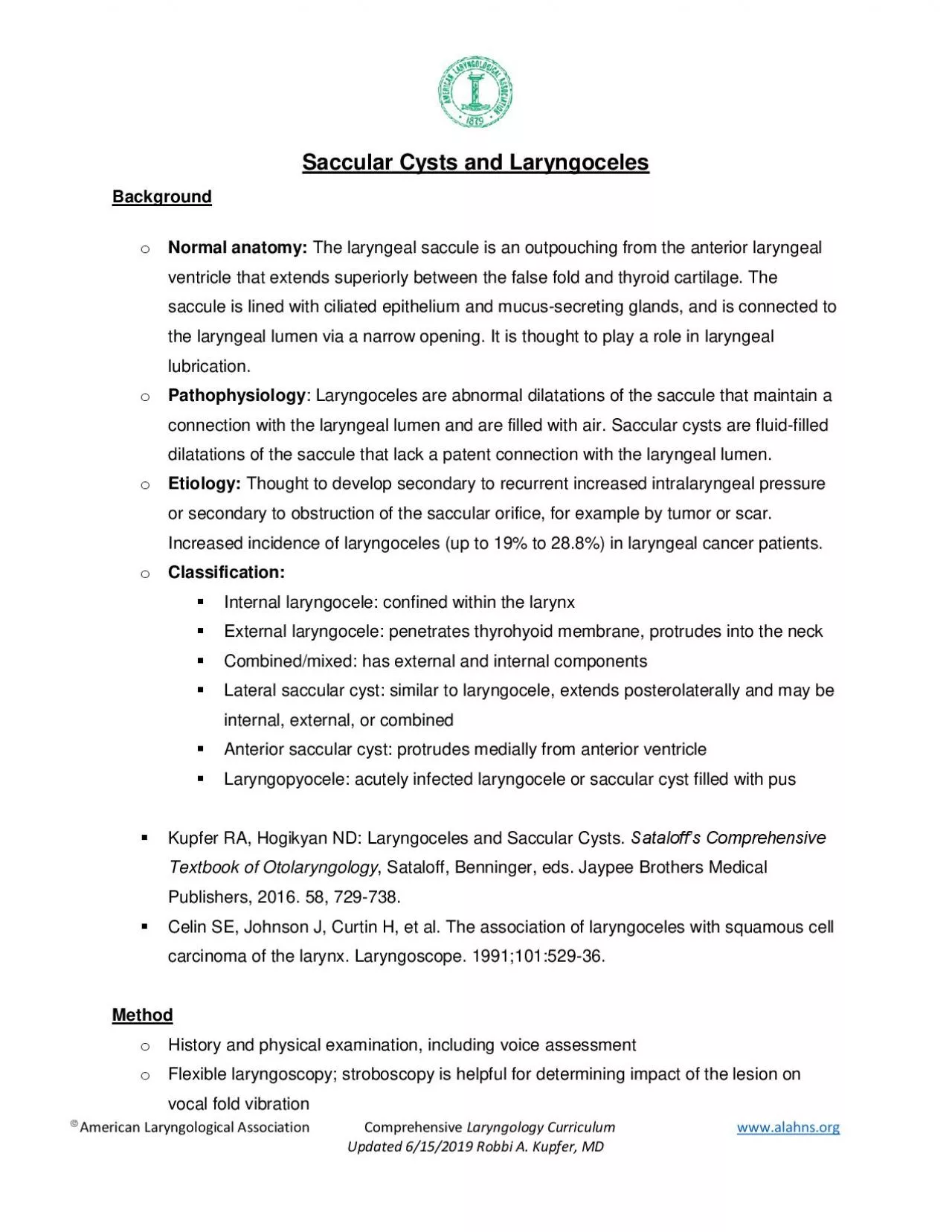

Comprehensive Laryngology Curriculum wwwalahnsorg Updated 61 52019 Robbi A Kupfer MD Saccular Cysts and Laryngoceles Background o Normal anatomy The laryngeal saccule is an outpouching fro ID: 942114
Download Pdf The PPT/PDF document "American Laryngological Association" is the property of its rightful owner. Permission is granted to download and print the materials on this web site for personal, non-commercial use only, and to display it on your personal computer provided you do not modify the materials and that you retain all copyright notices contained in the materials. By downloading content from our website, you accept the terms of this agreement.
American Laryngological Association Comprehensive Laryngology Curriculum www.alahns.org Updated 6/1 5/2019 Robbi A. Kupfer, MD Saccular Cysts and Laryngoceles Background o Normal anatomy: The laryngeal saccule is an outpouching from the anterior laryngeal ventricle that extends superiorly between the false fold and thyroid cartilage. The saccule is lined with ciliated epithelium and mucus - secreting glands, and is connected to the laryngeal lumen via a narrow opening . It is thought to play a role in laryngeal lubrication. o Pathophysiology : Laryngoceles are abnormal dilat at ions of the saccule that maintain a connection with the laryngeal lumen and are filled with air. Saccular cysts are fluid - filled dilatations of the saccule that lack a patent connection with the laryngeal lumen. o Etiology: Thought to develop secondary to recurrent increased intralaryngeal pressure or secondary to obstruction of the saccular orifice, for example by tumor or scar. Increased incidence of laryngoceles (up to 19% to 28.8%) in laryngeal cancer patients. o Classification: Internal laryngocele : confined within the larynx External laryngocele : penetrate s thy rohyoid membrane , protrude s into the neck Combined/mixed: has external and internal component s Lateral saccular cyst: similar to laryngocele, extends posterolaterally and may be internal, external, or combined Anterior saccul
ar cyst: protrude s medially from anterior ventricle Laryngopyocele: acutely infected laryngocele or saccular cyst filled with pus Kupfer RA, Hogikyan ND: Laryngoceles and Saccular Cysts. Sataloff’s Comprehensive Textbook of Otolaryngology , Sataloff, Benninger, eds. Jaypee Brothers Medical Publishers, 2016. 58, 729 - 738. Celin SE, Johnson J, Curtin H, et al. The association of laryngoceles with squamous cell carcinoma of the larynx. Laryngoscope. 1991;101:529 - 36. Method o History and physical examination, including voice assessment o Flexible laryngoscopy ; stroboscopy is helpful for determining impact of the lesion on vocal fold vibration American Laryngological Association Comprehensive Laryngology Curriculum www.alahns.org Updated 6/1 5/2019 Robbi A. Kupfer, MD o CT scan o Thorough evaluation for associated laryngeal malignancy Pertinent Findings o Clinical presentation : Small lesions are often asympto matic. Internal saccular cysts or laryngoceles present as a supraglottic mass and cause altered resonance, dysphonia if inhibiting vocal fold vibration, or airway obstruction. External components present as a neck mass that may enlarge with Valsalva maneuv er. o o Laryngoscopy : demonstrates submucosal fullness/mass of the false and aryepiglottic folds, which may extend into the piriform sinus in large lesions. o CT: air - filled or fluid - filled dilatation of the false vocal fold,
with extension through the thyrohyoid membrane into the lateral neck in external or combined cases. American Laryngological Association Comprehensive Laryngology Curriculum www.alahns.org Updated 6/1 5/2019 Robbi A. Kupfer, MD Bastian RW. Benign v ocal fold mucosal disorders. Flint PW, Haughey BH, Lund VJ, et al (eds), Cummings otolaryngology — Head Neck Surgery, 5th edn. MI, USA: Mosby; 2010. Kupfer RA, Hogikyan ND: Laryngoceles and Saccular Cysts. Sataloff’s Comprehensive Textbook of Otolaryngology , Sataloff, Benninger, eds. Jaypee Brothers Medical Publishers, 2016. 58, 729 - 738. Treatment o Observation: Appropriate for small or asymptomatic lesions. Monitoring is warranted to assess for increase in size and presence of associated laryngeal cancer. o Surgical drainage: Transcervical or endoscopic drainage or marsupialization may be performed as a temporizin g measure in cases of laryngopyocele or airway obstruction, but are inadequate for definitive management. Holinger LD, Barnes DR, Smid LJ, et al. Laryngocele and saccular cysts. Ann Otol Rhinol Laryngol. 1978;87:675 - 85. Civantos FJ, Holinger LD. Laryngoc eles and saccular cysts in infants and children. Arch Otolaryngol Head Neck Surg. 1992;118:296 - 300. o Endoscopic excision: Most internal and even some combined laryngoceles and saccular cyst s can be managed endoscopically via s uspension microlaryngoscopy, often facilitated with
laser for dissection . Technique includes l ateral curvilinear incision through false fold, identification of the cyst wall to ensure complete excision, and exploration of the lateral extent, which may require dissectio n laterally to t he thyroid ala. Dissection proceeds inferiorly and medially, taking care to avoid injury to the true vocal fold. American Laryngological Association Comprehensive Laryngology Curriculum www.alahns.org Updated 6/1 5/2019 Robbi A. Kupfer, MD Hogikyan ND, Bastian RW. Endoscopic CO 2 laser excision of large or recurrent laryngeal saccular cysts in adults. Laryngoscope. 1997;107:260 - 5. o Transcervical excision: For laryngoceles and saccular cysts with very large external components. Begin with microlaryngoscopy to evaluate for associated malignancy. Perform h orizontal incision through thyrohyoid membrane, identify thyroid ala and dissect laterally until the lesion is identified protruding through the thyrohyoid membrane. Bluntly dissect out the sac until only the internal laryngeal component remains attached. The endolaryngeal component can typically be teased out with blunt dissection and gentle traction . Once entire lesion is out, clamp the base and suture ligate. Laryngofissure is rarely necessary. Kupfer RA, Hogikyan ND: Laryngoceles and Saccular Cysts. Sataloff’s Comprehensive Textbook of Otolaryngology , Sataloff, Benninger, eds. Jayp ee Brothers Medical Publishers, 2016. 58, 729 - 738